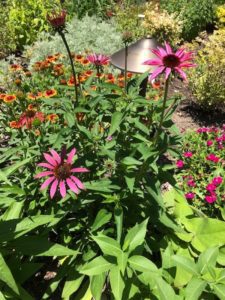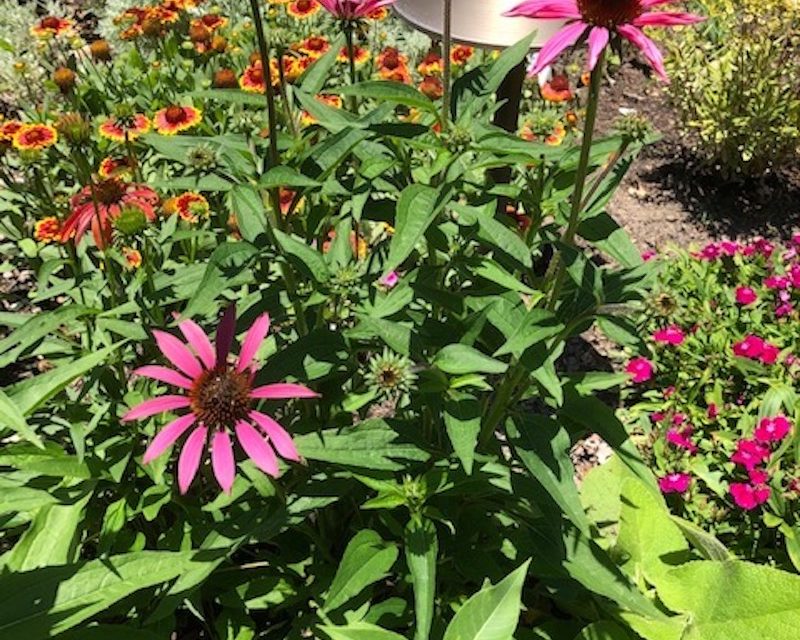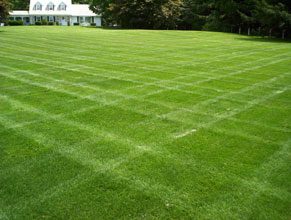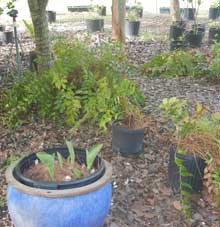 Some of our flowers look so sad this time of the year with the heat and humidity. But… take heart, there are some plants that thrive in the heat and continue to look good through it all. Many of them are natives that have been embraced as nursery plants. European and British landscapers call them “Prairie Plants” and they are currently all the rage over there. It is interesting to see what we might recognize as meadow “weeds” in naturalistic plantings around the globe done by internationally famous garden designers.
Some of our flowers look so sad this time of the year with the heat and humidity. But… take heart, there are some plants that thrive in the heat and continue to look good through it all. Many of them are natives that have been embraced as nursery plants. European and British landscapers call them “Prairie Plants” and they are currently all the rage over there. It is interesting to see what we might recognize as meadow “weeds” in naturalistic plantings around the globe done by internationally famous garden designers.
One of my personal favorites is Coneflower (Echinacea purpurea). Although it is a short-lived perennial (five years or less), it readily reseeds. The off spring might not look like the parent since it is non-clonal, but that is part of the fun. Try to find a variety that is as close to the native as possible – that is just plain Echinacea purpurea and not the hybrids that might go by names such as “Pink Poodle” or “Tomato Soup.” The Chicago Botanic Garden is doing Coneflower trials to see which new hybrids are worth the money and which last the longest and there are some surprising results. I do like Echinacea purpurea “Magnus” because it seems the closest to the original native form.
Salvias – Be still my heart. I have never met a Salvia that I did not like. Pollinators love them, there are many varieties and colors, and they are deer resistant. What is not to like? If they look tatty, cut them back and off they will go again. My favorites are Salvia “Amistad” (from Argentina of all places- Salvia guaranitica x gesniiflora), Salvia “Black and Bloom” or “Black and Blue” (Salvia guaranitica), Salvia splendens “Lighthouse Purple” (never stops blooming and looking great), and newer varieties known as the “Rockin” series. – Rockin Purple, Rockin the Blue Suede shoes and others. They do not spread by seeds, but you can split up clumps and/or take cuttings to root in the spring.
Another native is Rudbeckia hirta or fulgida. This is your classic Black-eyed Susan that you often see by the side of the road. Hungry deer can nibble on them occasionally so you might have to give them a spray of deer repellent. They reproduce well from seeds so when I deadhead them, I scatter the flower heads in the garden to see where they will come up next. When you buy them at the nursery, they need quite a bit of water to get started in the heat. They look great planted in drifts through out the garden for a bright splash of yellow.
Then there is a real pollinator favorite, Cuphea vermilionaire or firecracker plant. (There are several plants referred to as “firecracker plants” and that is why I use the Latin binomial) Cuphea can be grown as an annual, but with our increasingly warm winters, mine bloomed and flourished all winter long. Hummingbirds and bees absolutely adore this plant. Warning—it can get quite large. Mine is four feet by four feet. You can trim it to keep it in control. It is not deer resistant, but can be grown in a container on a deck to keep little cloven-footed minions from nibbling.
Those are just a few of my personal favorites to give you blooms throughout the heat of our summer and many times well into the autumn and winter. It is also important in the summer to be aware of certain gardening tasks that will help your plants survive this steamy weather.
Irrigation – For heavens sake, if we get one of those afternoon thunderstorms, turn off your irrigation. More plants are killed from too much water than too little. Rainwater is much better for your plants than county water with its chemical treatment, but too much of a good thing is just too much of a good thing. Root rot and fungal diseases are very real problems right now. If you do need to irrigate, remember that early in the morning is the best time – before the sun heats up the soil. If you water at night, moisture can cause some disease issues and if you water in the heat of the day, most of it evaporates before the plant is able to take the water up from the roots.
Mulch – Mulching is always helpful to keep the soil cooler. I have been using mushroom compost as mulch. It helps enrich the soil as the nutrients leach down, it keeps weed growth down, and it will keep the soil cooler.
Weeds – Weeds love hot and moist conditions. The worst weed you will see now is Chamberbitter. This innocuous looking little weed has hundred of seeds under its stems and can grow to six feet tall. It spreads like crazy, but fortunately can be easily pulled out when young. Dog fennel grows well here and looks like a small fluffy tree. Various spurges will try to take over your garden beds as well. Pull, pull, and pull. Do not compost these unless your yard waste goes to a professional composter where the temperature is so high that weed seeds will be killed.
With just a little early morning effort, you can keep your garden going until we have our autumn cool down. Plants are pretty tough and they will take the heat without too much babying.









